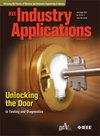电力系统故障时电动汽车充电器响应的实际测试与建模
IF 4.5
2区 工程技术
Q2 ENGINEERING, ELECTRICAL & ELECTRONIC
引用次数: 0
摘要
随着电动汽车的普及,消费者越来越多地将其作为传统内燃机驱动汽车的替代品。电动汽车充电器通过电力电子接口与配电网集成,提供显著的控制和操作灵活性。该行业正在迅速适应这种快速出现的负载类型,现在需要一种强大的手段来了解它们对电力系统运行的影响。本文提出了一种建模方法,以捕捉在一系列网络故障条件下这些充电器对电力系统的总体动态影响。利用电网模拟器对6种常用电动汽车在各种电源干扰下进行了经验测试,并对其故障通过性能进行了表征。这六辆车的欠压承受能力差异很大,故障电压阈值在0.3到0.7 pu之间,导致电动汽车要么停止充电2到10秒,要么完全锁定。利用收集到的经验数据,建立并验证了电动汽车的复合动态载荷模型。验证过程证明了总负荷模型能够准确捕获由于电动汽车故障穿越而导致的负载赤字,以响应变速器级故障。该模型适用于广域电力系统研究,可提高模拟电网负荷响应的准确性,用于频率评估、运行规划和其他系统分析。本文章由计算机程序翻译,如有差异,请以英文原文为准。
Practical Testing and Modeling of Electric Vehicle Charger Responses During Power System Faults
As electric vehicles gain popularity, consumers increasingly adopt them as an alternative to traditional internal combustion engine-driven vehicles. Electric vehicle chargers integrate with distribution networks via power electronic interfaces, offering significant control and operational flexibility. The industry is quickly adapting to this rapidly emerging load type, and now requires a robust means for understanding their impact on power system operations. This paper presents a modeling approach to capture the aggregate dynamic impact of these chargers on the power system in response to a range of network fault conditions. Six commonly available electric vehicles were empirically tested under various supply disturbances using a grid simulator, and their fault ride-through performances have been characterised. The undervoltage withstand capability of the six vehicles varied considerably, with fault voltage thresholds ranging between 0.3 and 0.7 pu leading to electric vehicles either ceasing charging for between ∼2 and 10 seconds, or locking out completely. A composite dynamic load model for electric vehicles was developed and validated, employing the collected empirical data. The validation process demonstrated the aggregate load model's capability to accurately capture the resulting load deficit owing to electric vehicle fault ride-through in response to transmission-level faults. The proposed model is suitable for application in wide-area power system studies to enhance the accuracy of simulated network load response for frequency assessments, operations planning, and other system analyses.
求助全文
通过发布文献求助,成功后即可免费获取论文全文。
去求助
来源期刊

IEEE Transactions on Industry Applications
工程技术-工程:电子与电气
CiteScore
9.90
自引率
9.10%
发文量
747
审稿时长
3.3 months
期刊介绍:
The scope of the IEEE Transactions on Industry Applications includes all scope items of the IEEE Industry Applications Society, that is, the advancement of the theory and practice of electrical and electronic engineering in the development, design, manufacture, and application of electrical systems, apparatus, devices, and controls to the processes and equipment of industry and commerce; the promotion of safe, reliable, and economic installations; industry leadership in energy conservation and environmental, health, and safety issues; the creation of voluntary engineering standards and recommended practices; and the professional development of its membership.
 求助内容:
求助内容: 应助结果提醒方式:
应助结果提醒方式:


